

What's the science behind mink and coronavirus? At Home. Covid-19 News: Live Updates. When infections began rising sharply in the U.S. in September, the growth was driven largely by outbreaks in the Upper Midwest.
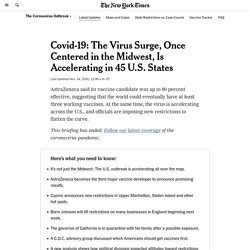
States like North Dakota and Wisconsin soon became the hardest hit in the nation, relative to their size, and the region continues to struggle. Now, though, with the whole country’s daily average of new cases is as high as it has ever been — over 171,000 — the most rapid growth is happening elsewhere. Nine states are reporting more than twice as many new cases a day as they did two weeks ago, and none of them are in the Midwest.
The surges in those states — Arizona, California, Delaware, Louisiana, Maryland, New Hampshire, New Mexico, Pennsylvania and Vermont — reflect a still-escalating national crisis. COVID-19: What you need to know about the coronavirus pandemic on 23 November. This daily round-up brings you a selection of the latest news and updates on the COVID-19 coronavirus pandemic, as well as tips and tools to help you stay informed and protected.
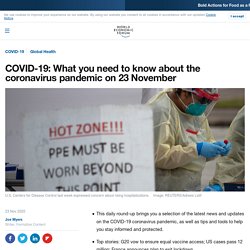
Top stories: G20 vow to ensure equal vaccine access; US cases pass 12 million; France announces plan to exit lockdown. 1. How COVID-19 is affecting the globe Confirmed cases of COVID-19 have now passed 58.6 million globally, according to the Johns Hopkins Coronavirus Resource Center. The number of confirmed deaths stands at more than 1.38 million. Covid Kills More Men Than Women. Experts Still Can’t Explain Why. WIRED. Une médecine sous influence, par Philippe Descamps (Le Monde diplomatique, novembre 2020) «Je refuse aujourd’hui de recommander le port du masque pour tous, et jamais le gouvernement ne l’a fait.
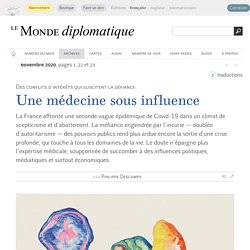
Si nous le recommandions, ce serait incompréhensible. » De tels propos n’émanent pas de « rassuristes » ou autres « complotistes ». Une pandémie, deux avenirs, par Robert Boyer (Le Monde diplomatique, novembre 2020) Denmark’s mink farmers count cost of botched cull. Auftaktveranstaltung am 11. November - Digitaler Kapitalismus - Online-Kongress 2020.
Sealing Pandora's Box. On many fronts, this is a time of great challenge.
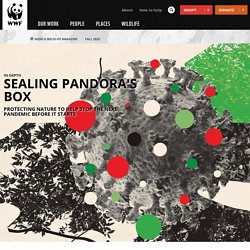
The list of Earth’s latest symptoms is long and foreboding: wildfires raging across California, the Amazon, Australia, and elsewhere; coastal communities hammered by storm surges; megacities shrouded with hazardous smog; crops wilting in the heat. And now we must add a global pandemic to that list. At WWF, we know that any solution must be driven by science and also locally developed through direct and collaborative partnerships with the people most immediately affected. For many people, the impacts of shrinking natural habitats, biodiversity loss, and climate change seem far away—tragic spectacles beamed to their TV sets from somewhere else. Une pandémie, deux avenirs, par Robert Boyer (Le Monde diplomatique, novembre 2020) Ten ways coronavirus crisis will shape world in long term.
COVID’s Impact in Real Time: Finding Balance Amid the Crisis. "This game is a good way to raise awareness among the personnel and residents about the risks associated with not respecting hygiene rules." What if we fought the coronavirus with a game?
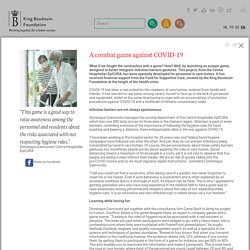
How? Well, by launching an escape game, designed to better integrate infection barriers gestures. This project, from the Centre Hospitalier EpiCURA, has been specially developed for personnel in care homes. It has received financial support from the Fund for Supportive Care, created by the King Baudouin Foundation at the height of the health crisis. Netherlands to return to ‘partial lockdown’ amid rising coronavirus cases. Protecting health during COVID-19 and beyond: A global examination of paid sick leave design in 193 countries - PubMed. Medicines Patent Pool can be conduit for access to affordable Covid-19 treatments. The WHO appeal.

Following an appeal by the President of Costa Rica, Carlos Alvarado, to create a voluntary pool of intellectual property rights for Covid-19 treatments, WHO on Friday launched the COVID-19 Technology Access Pool (C-TAP) with a “Solidarity Call to Action.” This initiative complements the European Commission-led Covid-19 Tool Access Accelerator (ACT), which has already raised over 7 billion Euros for R&D and expanded distribution of future drugs. ACT has been supported by industry, non-profits such as the Bill and Melinda Gates Foundation and the Global Alliance for Vaccines (GAVI), and the UN-hosted drug purchasing facility, UNITAID. Through C-TAP, WHO is now asking public and private funders of R&D to commit to IP knowledge-sharing, in particular through open licensing. Access advocates have underlined that products receiving public funding for their R&D, in particular, should be exempt from exclusive patent protections. GS: How does the Medicines Patent Pool operate?
Interview – BBC World Business Report – Will a coronavirus vaccine reach the developing world? – IFPMA. The biopharmaceutical industry has made addressing the pandemic its top priority, devoting its resources, expertise, know-how, and intellectual assets to developing potential treatments and vaccines at record speed, while committing to and engaging in unprecedented levels of international collaboration and coordination through initiatives such as ACT-A, ACTIV and CEPI to ensure equitable access to products being developed.
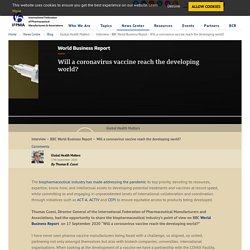
Thomas Cueni, Director General of the International Federation of Pharmaceutical Manufacturers and Associations, had the opportunity to share the biopharmaceutical industry’s point of view on BBC World Business Report on 17 September 2020 “Will a coronavirus vaccine reach the developing world?” I have never seen pharma vaccine manufacturers being faced with a challenge, so aligned, so united, partnering not only amongst themselves but also with biotech companies, universities, international organisations.
5 lessons as COVID-19 unfolds for future pandemics – Insights from the biopharmaceutical industry – IFPMA. Winter will make the pandemic worse. Here’s what you need to know. As we head into the Northern Hemisphere fall with covid-19 still raging in the US and a number of other parts of the world, two data points provide cause for extra concern.

One is that the seasonal flu—a respiratory viral infection like covid-19—is much more active in the winter. Last year in the US, there were 40 times as many flu cases in the fall and winter months as in the previous spring and summer. Historically, those cooler months see tens of times as many seasonal flu infections in temperate regions. (In tropical regions, the flu tends to peak during the rainy season, though not as strongly.) The other is that the death toll from the 1918 influenza outbreak—the only pandemic to have killed more Americans than this one so far, and one of the deadliest in global history—was five times as high in the US during the late fall and winter as during the summer.
How likely is that? The results are not encouraging. What happens to the virus in the winter? No such patterns have emerged. Overhauling Health Systems – IMF F&D. Webinar: 'The role of a European Health Data Space in a pandemic' - DIGITALEUROPE. Greater harmonisation of clinical trial regulations would help the fight against COVID-19. Since the global outbreak of SARS‑CoV‑2 (COVID-19) in early 2020, many research institutions, supported by public and private funders, have taken action to accelerate R&D on vaccines and treatments.
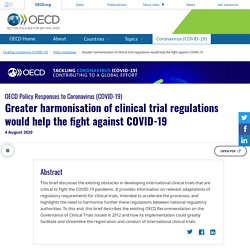
As a result, many new pre-clinical research studies and clinical trials have been launched, and hundreds of clinical trials related to COVID-19 have been registered. While most of these are testing drug candidates, several potential vaccines are also being tested. Information on these clinical trials can be found on the World Health Organisation (WHO) website and in the OECD brief Treatments and a vaccine for COVID-19: the need for co-ordinating policies on R&D, manufacturing and access.
Adaptation of regulatory requirements and processes typically includes: Some international initiatives have been developed to facilitate exchanges between regulatory authorities on adapted clinical trial registration requirements. Further reading. Workshop on Minding Neurotechnology: Delivering responsible innovation for health and well-being. Bionic eye helps people who are blind read letters again.
How artificial intelligence can help detect rare diseases: Researchers show that using portrait photos in combination with genetic and patient data improves diagnoses. Every year, around half a million children worldwide are born with a rare hereditary disease.
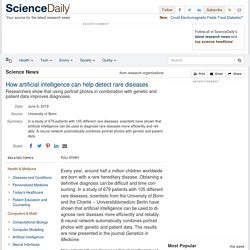
Obtaining a definitive diagnosis can be difficult and time consuming. In a study of 679 patients with 105 different rare diseases, scientists from the University of Bonn and the Charité -- Universitätsmedizin Berlin have shown that artificial intelligence can be used to diagnose rare diseases more efficiently and reliably. A neural network automatically combines portrait photos with genetic and patient data. The results are now presented in the journal Genetics in Medicine. Artificial intelligence, drug repurposing and peer review. It is critical we learn from the HCQ experience as we look for immediate medical solutions to this crisis. The COVID-19 pandemic has resulted in an unprecedented number of other therapeutic proposals, from peer-reviewed and preprint publications to blog posts, tweets, television and other communication channels.
No matter how rational or sound, this many proposals cannot be systematically evaluated and prioritized by any single group, institution or regulator. Trump just got a dose of Regeneron’s unapproved antibody drug for covid. The president of the United States, Donald Trump, tested positive for covid-19 and within 24 hours had received an experimental, cutting-edge antibody treatment not available to other Americans.
In a statement released Friday, the White House said Trump had received “a single 8-gram dose” of the biotech treatment, which belongs to a promising new class of antiviral drugs. The president “remains fatigued but in good spirits” after getting the emergency infusion, according to White House doctor Sean Conley. Editing the book of life - A tool for editing genomes wins the Nobel prize for chemistry. ALL ORGANISMS suffer from viral infections, and all have developed immune systems of one sort or another to combat them. Bacteria are no exception. Some snip small sequences of DNA from viral interlopers and copy them into their own genomes, thus creating a genetic scrapbook by which to recognise such aggressors, should they come again.
Helping to work out the details of this process has won Emmanuelle Charpentier of the Max Planck unit for the science of pathogens, in Berlin, and Jennifer Doudna of the University of California, Berkeley, this year’s Nobel prize for chemistry. Their prize is not, though, for the mere discovery of a bacterial mechanism of immunity. España avisa a la UE de que con la llegada de la gripe puede limitar el uso de PCR a sanitarios y mayores. Los países de la Unión Europea (UE) se preparan para un invierno complicado. El auge de la segunda ola en buena parte del continente y la llegada de las infecciones respiratorias habituales en esta época del año —la gripe la más importante— ha llevado a algunos países a prepararse por si es necesario limitar las pruebas diagnósticas como las PCR a solo algunos colectivos, como profesionales sanitarios o personas mayores. Sanidad pacta con las comunidades poner en marcha la auditoría de los fallos cometidos en la pandemia España es el que de forma más clara lo ha explicado en las reuniones preparatorias de la estrategia a seguir del Comité de Seguridad Sanitaria de la Comisión Europea.
Este órgano está formado por expertos de los Gobiernos y el representante español suele ser el director de emergencias del Ministerio de Sanidad, Fernando Simón. Las 15 páginas de las recomendaciones describen una situación con notables diferencias entre los Estados miembros. Company Profile for Pharmaceutical Strategies Group. Greenlane Renewables Inc. (Greenlane) (TSXV: GRN / FSE: 52G) today announced that its wholly-owned subsidiary, Greenlane Biogas North America Ltd., has signed an $7.7 million (US$5.8 million) contract for a new renewable natural gas (RNG) project developed by San Francisco, California-based Brightmark LLC (Brightmark).
The multiple-site dairy farm project in the State of Florida will utilize Greenlanes pressure swing adsorption (PSA) biogas upgrading systems. This is a showcase project and second contract with Brightmark, one of the leading RNG project developers in the United States, said Brad Douville, President & CEO of Greenlane. Were honored to be a trusted collaborator for this exciting new project in Florida. Greenlanes biogas upgrading systems will be used in Brightmarks Sobek RNG project in Okeechobee County, Florida, at four Larson family dairy farms. About Brightmark About Greenlane Renewables. Athletes Are Conquering Distance. Sports Will Never Be the Same. Airborne transmission of SARS-CoV-2. There is overwhelming evidence that inhalation of severe acute respiratory syndrome coronavirus 2 (SARS-CoV-2) represents a major transmission route for coronavirus disease 2019 (COVID-19). There is an urgent need to harmonize discussions about modes of virus transmission across disciplines to ensure the most effective control strategies and provide clear and consistent guidance to the public.
To do so, we must clarify the terminology to distinguish between aerosols and droplets using a size threshold of 100 μm, not the historical 5 μm (1). This size more effectively separates their aerodynamic behavior, ability to be inhaled, and efficacy of interventions. Viruses in droplets (larger than 100 μm) typically fall to the ground in seconds within 2 m of the source and can be sprayed like tiny cannonballs onto nearby individuals.
Because of their limited travel range, physical distancing reduces exposure to these droplets. Covid 19 risk assessment increased transmission 12th update september 2020. Charting the pandemic over the next 12 months — and beyond. Think back through the pandemic. Charting the pandemic over the next 12 months — and beyond. Paper series. Covid-19 and beyond - The world needs a better World Health Organisation. Explainer: Why Investment in Public Health Can Fight Epidemics. Rob Yates explains why the spread of the coronavirus beyond China continues to highlight disparities between nations that have invested in public health services and those that have not. Since the SARS epidemic in the early 2000s, China has trebled spending on its health services, and consequently has met the coronavirus outbreak with a much more robust response.
Healthy environment, healthy lives - Friends of Europe. The ticking time bomb: cardiovascular diseases - Friends of Europe. À quand une Europe de la santé ? À quand une Europe de la santé ? Global Prevalence of Malnutrition: Evidence from Literature. 1. Introduction. Global Targets 2025. Healthy diet. Obesity and overweight.
Fact sheets - Malnutrition. 3. Global and regional food consumption patterns and trends. The Access to COVID-19 Tools (ACT) Accelerator Timeline of WHO's response to COVID-19. WHO Coronavirus Disease (COVID-19) Dashboard. Goal 6: Clean Water and Sanitation. Goal 3: Good Health and Well-being. Human Brain Project Home. Environmental Intelligence: Applications of AI to Climate Change, Sustainability, and Environmental Health. The Future of Artificial Intelligence in Medicine and Imaging.
Smarter Hospitals: How AI-Enabled Sensors Could Save Lives. Conference reveals the power of using artificial intelligence to discover new drugs. Bringing the predictive power of artificial intelligence to health care. Improving global health equity by helping clinics do more with less. Musculoskeletal disorders and psychosocial factors at work. Our failure to prevent known risks. Biological agents and prevention of work-related diseases: a review - Safety and health at work. European Survey of Enterprises on New and Emerging Risks (ESENER) - Safety and health at work. Covid-19 : le monde face à l’arrivée de la deuxième vague. Can supercomputers help find a COVID-19 treatment?
Seven visions of the future of healthcare. The future of healthcare: our vision for digital, data and technology in health and care. Future of healthcare: What will medicine look like in 2040? 9 Future of Work Trends Post-COVID-19. COVID-19 is accelerating future of work trends.